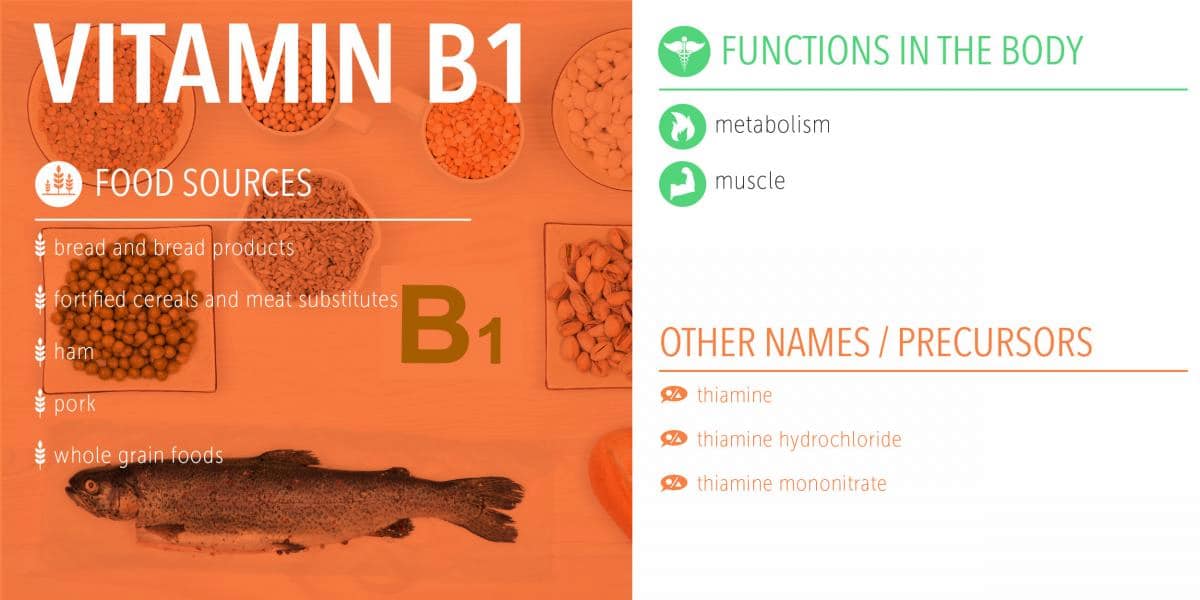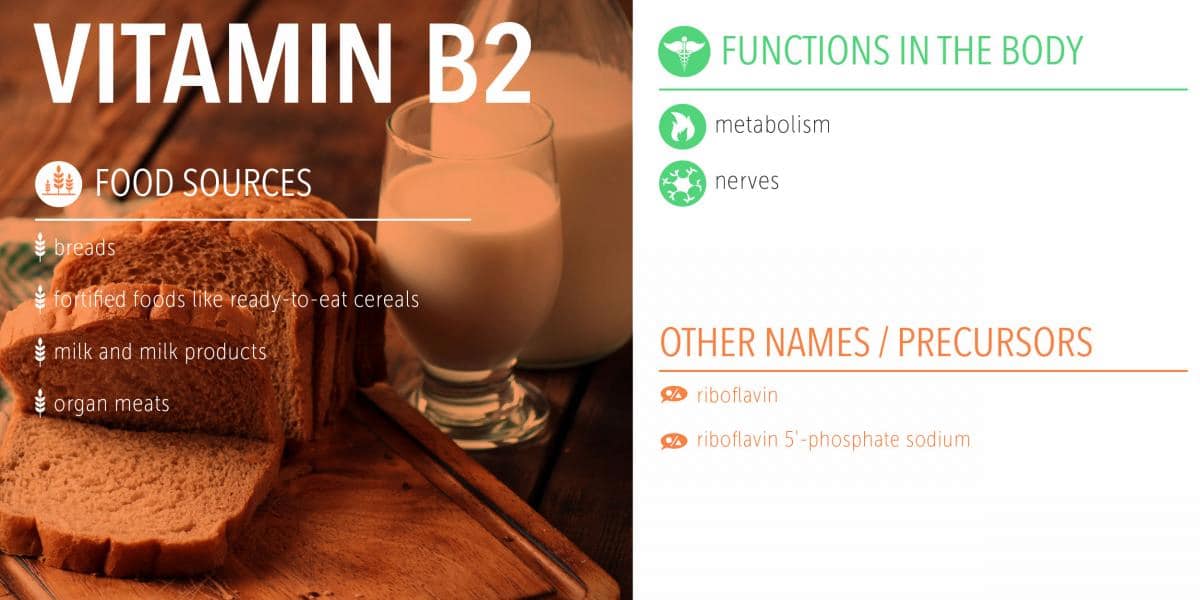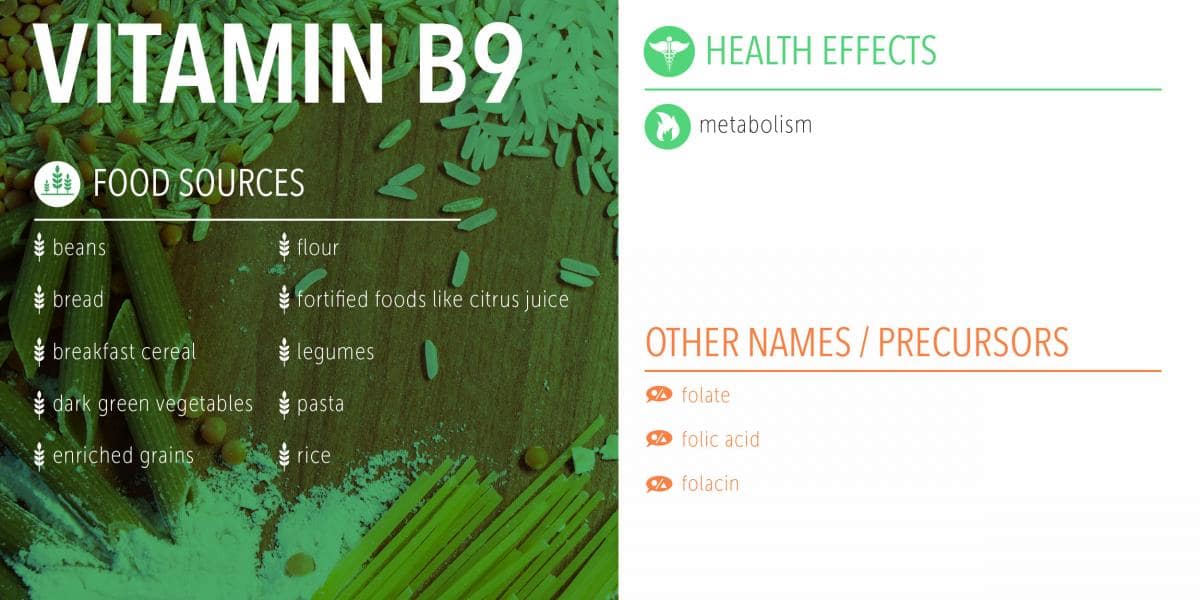B vitamins primarily help our bodies convert food into fuel that we use for energy. While there are eight B vitamins found in foods, we are just going to focus on four: B1, B2, B3, and B9. (“Gaps” in the numbering of B vitamins from 1 to 12 are substances that were discovered but were later not considered to be B vitamins, or were found to have no nutritional value.) Most of these vitamins, often referred to as other names, are probably more recognizable. For example, vitamin B1 is commonly known as thiamine, vitamin B2 as riboflavin, vitamin B3 as niacin, and vitamin B9 as folate or folic acid. Read on to learn more about their health benefits, sources, and how much you should be aiming to incorporate into your diet.
What other health benefits do these micronutrients have?
Along with helping produce energy, B vitamins also enable the nervous system to function properly and are key for a healthy liver, skin, hair, and eyes. While many of these vitamins work together, each vitamin has its own specific roles and benefits. For example, vitamin B1 helps the body produce new cells and strengthens the immune system. Vitamin B2 works as an antioxidant, which protects cells and DNA from damage. It is also important for growth and red blood cell production. Vitamin B3 helps the body make hormones in your adrenal glands and helps suppress inflammation by improving circulation. And last but not least, vitamin B9 is necessary for proper brain function and is especially important at times when cells and tissues are growing rapidly, such as pregnancy.

How much vitamin B1 should I aim for, and what foods should I focus on?
Foods that are rich in vitamin B1 are bread and bread products, fortified cereal and meat substitutes, ham, pork, and whole grain foods. To help you better understand how much vitamin B1 you should be consuming and how much of it is in certain foods, see the tables below.
Recommended Dietary Allowances (RDAs) for Vitamin B1
Institute of Medicine. Food and Nutrition Board. Dietary Reference Intakes: Thiamin, Riboflavin, Niacin, Vitamin B6, Folate, Vitamin B12, Pantothenic Acid, Biotin, and Choline. Washington, DC: National Academy Press; 1998.
Age | Male | Female | Pregnancy | Lactation |
Birth to 6 months* | 0.2 mg | 0.2 mg | ||
7-12 months* | 0.3 mg | 0.3 mg | ||
1-3 years | 0.5 mg | 0.5 mg | ||
4-8 | 0.6 mg | 0.6 mg | ||
9-13 years | 0.9 mg | 0.9 mg | ||
14-18 years | 1.2 mg | 1.0 mg | 1.4 mg | 1.4 mg |
19-50 years | 1.2 mg | 1.1 mg | 1.4 mg | 1.4 mg |
51+ years | 1.2 mg | 1.1 mg |
* Adequate Intake (AI)
Selected Food Sources of Vitamin B1
U.S. Department of Agriculture, Agricultural Research Service. USDA National Nutrient Database for Standard Reference, Release 27. Nutrient Data Laboratory home page, 2014.
Food | Milligrams (mg) per serving |
Breakfast cereals, fortified with 100% of the daily value for vitamin B1, 1 serving | 1.5 |
English muffin, plain, enriched, 1 muffin | 0.3 |
Macaroni, whole wheat, cooked, 1 cup | 0.2 |
How much vitamin B2 should I aim for, and what foods should I focus on?
Vitamin B2 is found in breads, fortified foods such as ready-to-eat cereals, milk and milk products, and organ meats. To help you better understand how much vitamin B2 you should be consuming and how much of it is in certain foods, see the tables below.
Recommended Dietary Allowances (RDAs) for Vitamin B2
Age | Male | Female | Pregnancy | Lactation |
Birth to 6 months* | 0.3 mg | 0.3 mg | ||
7-12 months* | 0.4 mg | 0.4 mg | ||
1-3 years | 0.5 mg | 0.5 mg | ||
4-8 | 0.6 mg | 0.6 mg | ||
9-13 years | 0.9 mg | 0.9 mg | ||
14-18 years | 1.3 mg | 1.0 mg | 1.4 mg | 1.6 mg |
19-50 years | 1.3 mg | 1.1 mg | 1.4 mg | 1.6 mg |
51+ years | 1.3 mg | 1.1 mg |
* Adequate Intake (AI)
Selected Food Sources of Vitamin B2
U.S. Department of Agriculture, Agricultural Research Service. USDA National Nutrient Database for Standard Reference, Release 27. Nutrient Data Laboratory Home Page, 2014.
Food | Milligrams (mg) per serving |
Beef liver, pan fried, 3 ounces | 2.9 |
Breakfast cereals, fortified with 100% of the daily value for vitamin B2, 1 serving | 1.7 |
Oats, instant, fortified, cooked with water, 1 cup | 1.1 |
Yogurt, plain, fat free, 1 cup | 0.6 |
Milk, 2% fat, 1 cup | 0.5 |
Beef, tenderloin steak, boneless, trimmed of fat, grilled, 3 ounces | 0.4 |
How much vitamin B3 should I aim for, and what foods should I focus on?
Beans, eggs, fish, meat, milk, nuts, poultry, and whole and enriched grains are all great sources of vitamin B3. To help you better understand how much vitamin B3 you should be consuming and how much of it is in certain foods, see the tables below.
Recommended Dietary Allowances (RDAs) for Vitamin B3
Age | Male | Female | Pregnancy | Lactation |
Birth to 6 months* | 2 mg | 2 mg | ||
7-12 months* | 4 mg | 4 mg | ||
1-3 years | 5 mg | 5 mg | ||
4-8 | 6 mg | 6 mg | ||
9-13 years | 9 mg | 9 mg | ||
14-18 years | 12 mg | 11 mg | 14 mg | 13 mg |
19+ years | 12 mg | 11 mg | 14 mg | 13 mg |
* Adequate Intake (AI)
Selected Food Sources of Vitamin B3
Food | Milligrams (mg) per serving |
Cereal, fortified, 1 cup | 27 |
Chicken, light meat, skinless 3 ounces | 11.7 |
Tuna, light, canned, packed in water, 3 ounces | 11.3 |
Turkey, light meat, skinless, 3 ounces | 10 |
Salmon, Chinook, 3 ounces | 8.5 |
Cereal, unfortified, 1 cup | 7 |
Beef, 90% lean, 3 ounces | 5.8 |
Peanuts, dry-roasted, 1 ounce | 3.8 |
Pasta, enriched, 1 cup | 2.4 |
Lentils, 1 cup | 2.1 |
Bread, whole-wheat, 1 slice | 1.3 |
How much vitamin B9 should I aim for, and what foods should I focus on?
Food sources of vitamin B9 include beans, bread, breakfast cereal, dark green vegetables, enriched grains, flour, fortified foods like citrus juice, legumes, pasta, and rice. To help you better understand how much vitamin B9 you should be consuming and how much of it is in certain foods, see the tables below.
Recommended Dietary Allowances (RDAs) for Vitamin B9
Institute of Medicine. Food and Nutrition Board (1998). Dietary Reference Intakes: Thiamin, Riboflavin, Niacin, Vitamin B6, Folate, Vitamin B12, Pantothenic Acid, Biotin, and Choline. Washington, DC, National Academy Press.
Age | Male | Female | Pregnancy | Lactation |
Birth to 6 months* | 65 mcg DFE* | 65 mcg DFE* | ||
7-12 months* | 80 mcg DFE* | 80 mcg DFE* | ||
1-3 years | 150 mcg DFE | 150 mcg DFE | ||
4-8 | 200 mcg DFE | 200 mcg DFE | ||
9-13 years | 300 mcg DFE | 300 mcg DFE | ||
14-18 years | 400 mcg DFE | 400 mcg DFE | 600 mcg DFE | 500 mcg DFE |
19+ years | 400 mcg DFE | 400 mcg DFE | 600 mcg DFE | 500 mcg DFE |
* Adequate Intake (AI)
Selected Food Sources of Vitamin B9
U.S. Department of Agriculture Agricultural Research Service. (2012). USDA National Nutrient Database for Standard Reference, Release 25.
Food | Micrograms (mcg) DFE per serving |
Beef liver, braised, 3 ounces | 215 |
Spinach, boiled, ½ cup | 131 |
Black-eyed peas (cowpeas), boiled, ½ cup | 105 |
Breakfast cereals, fortified with 25% of the daily value† | 100 |
Rice, white, medium-grain, cooked ½ cup† | 90 |
Asparagus, boiled, 4 spears | 89 |
Spaghetti, cooked, enriched, ½ cup† | 83 |
Brussels sprouts, frozen, boiled, ½ cup | 78 |
Spinach, raw, 1 cup | 58 |
† Fortified with folic acid as part of the folate fortification program.
Building a Better Diet with B Vitamins
Enjoying fortified foods like cereal, breads and other grains is one of the easiest ways to reach your daily vitamin B recommendations. I’m excited to see the ways that I can incorporate the B vitamins into my favorite meal of the day … breakfast! Egg on toast with a bowl of fortified cereal and milk sounds like a delicious start to the day!
This article was written by Tuesday Brooks, RD and reviewed by Kris Sollid, RD.



